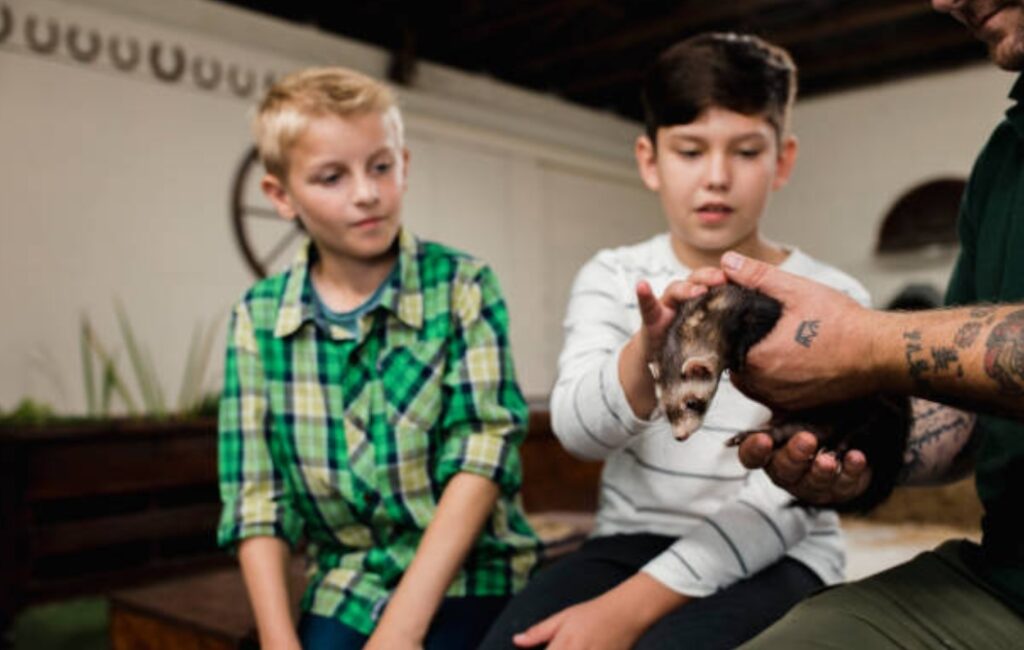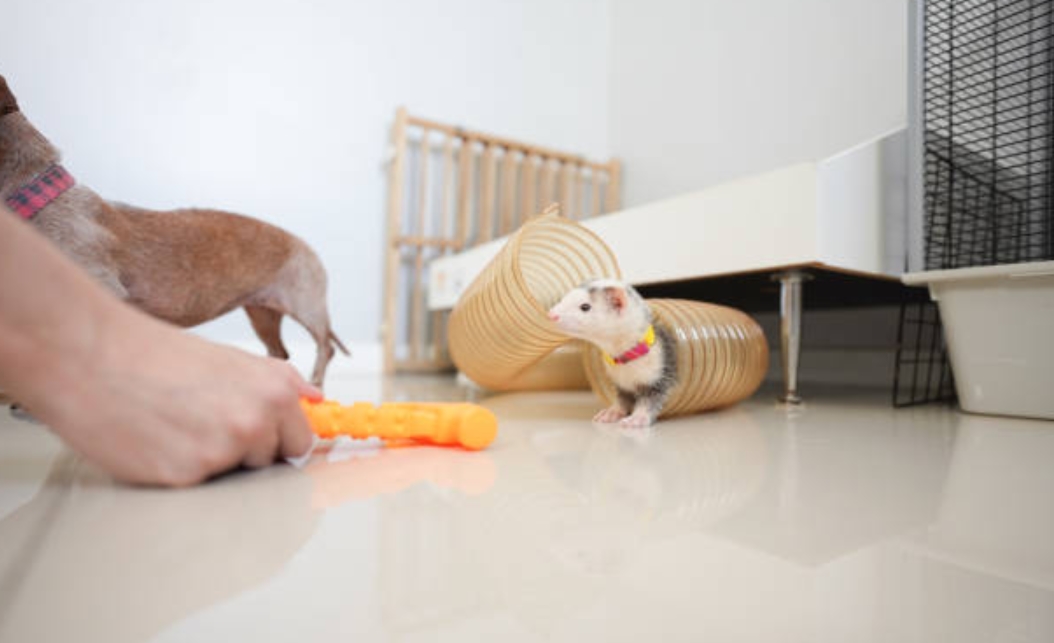If you have a ferret or are planning to get one, it’s important to understand ferret behavior. Ferrets are unique creatures and they have their own ways of communicating and showing their feelings. In this article, I will share with you some basic information on ferret behaviors and why it’s important to understand them.
Why understanding ferret behaviors is important?
Ferrets can’t talk to us like humans, so it’s important to pay attention to their body language, vocalizations, and behaviors to understand how they’re feeling. Understanding your ferret’s behaviors can help you bond with them, prevent health problems, and ensure their overall well-being.
For example, my ferret, Fuzzy, would often make a clucking sound with his tongue when he was happy and content. I noticed that he would also arch his back and puff up his tail when he was scared or felt threatened. Once I understood his behavior, I was able to give him the appropriate care and attention he needed.
Ferret Grooming Made Easy: Expert Grooming Secret Tips and Tricks
Ferret Body Language and What it Means

Ferrets use their bodies to communicate with us. Their body language can tell us whether they’re happy, scared, or feeling playful. Learning to read your ferret’s body language is important in understanding how they’re feeling.
Common body language signals and what they mean
When ferrets are happy, they will often wag their tail and make soft clucking sounds. They may also stand on their hind legs and bounce up and down. If your ferret is scared, it may arch back, puff up its tail, and flatten ears against its head. When ferrets are feeling playful, they may run around and do a “weasel war dance,” which is when they hop and twist their bodies.
How to respond to your ferret’s body language?
It’s important to respond appropriately to your ferret’s body language. If your ferret is happy and playful, you can play with them and give them attention. However, if they’re scared or feeling threatened, it’s important to give them space and let them calm down. It’s also important to ensure that your ferret’s environment is safe and comfortable for them.
For example, when I first got my ferret, Fuzzy, I noticed that he would often puff up his tail and flatten his ears when I would try to pick him up. I quickly realized that this was a sign that he was scared or feeling threatened. To make him feel more comfortable, I would give him some space and let him come to me when he was ready. Over time, Fuzzy learned to trust me and became more comfortable being handled.
Different Types of Ferret Vocalizations and How to Interpret Them
Ferrets communicate not only through body language but also through different vocalizations. Learning to interpret your ferret’s vocalizations can help you understand how they’re feeling and what they need.
Ferret Housing: 7 Tips to Creating a Safe Home for Your Pet
What do your ferret’s vocalizations mean?

Ferrets make a variety of sounds, from chirps and clucks to hisses and growls. When ferrets are happy and content, they will often make soft clucking sounds with their tongue. They may also chirp or make a purring sound. If your ferret is feeling scared or threatened, it may hiss or growl. Ferrets may also scream if they’re in pain or feel trapped.
How to respond to your ferret’s vocalizations?
It’s important to respond appropriately to your ferret’s vocalizations. If your ferret is making happy sounds, you can interact with them and give them attention. However, if they’re hissing or growling, it’s important to give them space and let them calm down. If your ferret is screaming or in pain, it’s important to take them to the vet as soon as possible.
For example, when my ferret, Fuzzy, was feeling scared or threatened, he would hiss and make a growling sound. I quickly learned that this was a sign that he needed some space and time to calm down. I would give him some time to himself and wait until he was feeling more relaxed before interacting with him again.
Common Ferret Behaviors and Habits, and How to Respond to Them
Ferrets have a unique set of behaviors that are important to understand in order to keep them happy and healthy. For example, when ferrets are feeling playful, they may do a “weasel war dance” or run around the room. This is a sign that they’re feeling energetic and want to play. If your ferret is hiding or burrowing, it may be a sign that they’re feeling scared or anxious.
Understanding ferret habits
Ferrets have specific habits that are important to recognize in order to ensure their well-being. For example, ferrets are naturally curious and love to explore their environment. They also have a strong instinct to burrow and hide in small spaces. Providing your ferret with toys and hiding spots can help them feel comfortable and happy in their environment.
How to respond to your ferret’s behaviors and habits?
It’s important to respond appropriately to your ferret’s behaviors and habits. If your ferret is feeling playful, you can play with them and provide them with toys to keep them entertained. However, if your ferret is hiding or appears scared, it’s important to give them space and let them calm down. Providing them with a safe and comfortable environment with hiding spots and toys can also help them feel more at ease.
For example, when my ferret, Fuzzy, would hide under the couch and refuse to come out, I realized that he was feeling scared or anxious. I would give him some space and wait until he was ready to come out on his own. I also provided him with a hiding spot in his cage, which he would use when he needed some alone time.
How to Take Care of a Ferret: 7 Essential Tips for Beginners
The Importance of Playtime and Socialization for Ferrets

Playtime and socialization are crucial for a ferret’s physical and mental well-being. Ferrets are social animals that require interaction with their human companions and other ferrets. Playtime provides them with the opportunity to burn off excess energy and engage in activities that stimulate their minds.
How to recognize positive and negative behaviors during playtime?
During playtime, it’s important to observe your ferret’s behavior to ensure that they’re having a positive experience. Positive behaviors may include playful movements, a wagging tail, and a relaxed body posture. Negative behaviors, on the other hand, may include hissing, biting, or aggressive behavior.
Tips for socializing your ferret
Socializing your ferret is important for their overall well-being. One way to socialize your ferret is by introducing them to other ferrets in a safe and controlled environment. It’s important to supervise all interactions and ensure that the ferrets are getting along. You can also socialize your ferret by spending time with them and providing them with plenty of opportunities for play and exploration.
For example, when I first brought home my ferret, Fluffy, she was shy and hesitant to interact with me. I made sure to spend plenty of time with her, playing and providing her with toys to keep her entertained. As she became more comfortable, I introduced her to other ferrets and supervised their interactions. Over time, Fluffy became more social and outgoing, and she now loves spending time with both me and her ferret friends.
Training Techniques for Desirable Behaviors
Training your ferret is an excellent way to enhance the bond between you and your pet while also promoting good behavior. By teaching your ferret basic commands, you can encourage good habits and discourage negative behaviors.
Positive reinforcement training techniques
Positive reinforcement training is an effective and humane method of teaching your ferret new behaviors. This type of training involves rewarding your ferret with treats or praise for exhibiting desirable behavior. Positive reinforcement encourages your ferret to repeat good behaviors, which can lead to long-lasting positive habits.
How to train your ferret to exhibit desirable behaviors
To train your ferret to exhibit desirable behaviors, start with basic commands like “come,” “sit,” and “stay.” Use treats or praise to reward your ferret for following the command. Be patient and consistent with your training, and don’t expect your ferret to learn everything at once.
For example, when I first started training my ferret, Whiskers, I began with basic commands like “come” and “sit.” I used treats to reward her when she followed the command correctly. Over time, I added more commands and increased the difficulty of the training.
Common behavior problems and How to Address it

Just like any pet, ferrets can develop behavior problems if they are not properly trained or socialized. Some common behavior problems in ferrets include biting, chewing, and digging. These problems can be caused by a variety of factors, such as boredom, lack of exercise, or improper training.
How to Train a Ferret: Effective Ferrets Training Tips and Tricks
- Biting: Ferrets are playful animals, but if they are not properly socialized, they may nip or bite. This can be caused by fear or lack of trust. It’s important to socialize your ferret from a young age and teach them that biting is not acceptable behavior.
- Chewing: Ferrets have a natural instinct to chew, but if they are not provided with appropriate chew toys, they may start to chew on household items. This behavior can also be caused by boredom or lack of exercise.
- Digging: Ferrets are natural diggers and may start to dig in inappropriate places, such as carpets or furniture. This behavior can be caused by a lack of appropriate digging toys or boredom.
How to address and correct behavior problems?
To address and correct behavior problems in your ferret, it’s important to identify the underlying cause of the problem. For example, if your ferret is biting, you may need to socialize them more or train them not to bite. If your ferret is chewing on household items, you may need to provide them with more appropriate chew toys.
It’s also important to be patient and consistent with your training. Use positive reinforcement techniques to encourage good behavior and discourage negative behavior. Reward your ferret with treats or praise when they exhibit desirable behavior and redirect its attention when they exhibit undesirable behavior. Ferret Grooming: most relevant content around the net be.chewy.com, rspca.org.uk, ncbi.nlm, totallyferret.org.
For example, when I noticed that my ferret, Bandit, was chewing on household items, I provided her with more appropriate chew toys and praised her when she chewed on them instead. I also redirected her attention when she started to chew on inappropriate items by offering her a chew toy.
Common Questions and Answers for Ferret Behavior
- What human behaviors are affecting black footed ferrets?
- Human activities like habitat loss, hunting, and disease transmission are affecting black-footed ferret populations.
- What is normal ferret behavior?
- Normal ferret behavior includes playing, exploring, sleeping, and digging.
- What ferret behavior means?
- Ferret behavior can communicate a variety of things, such as excitement, fear, aggression, or relaxation.
- What are ferrets estrus behavior?
- During estrus, female ferrets may exhibit behaviors like increased vocalization, restlessness, and willingness to mate.
- Where do pet shops obtain ferret kits ferret play behavior?
- Pet shops may obtain ferret kits from breeders or other pet stores. Ferret play behavior includes activities like running, hiding, and chasing objects.
- What is black-footed ferret prerelease behavioral conditioning preconditioning?
- Black-footed ferret prerelease behavioral conditioning preconditioning is a process of training captive-bred ferrets for survival in the wild.
- How do I deal with aggressive ferret behavior towards other ferrets?
- You can try to separate the ferrets, provide them with separate living spaces, and gradually reintroduce them with supervision.
- What are signs of abused ferret behavior?
- Signs of abused ferret behavior may include fearfulness, aggression, reluctance to interact, and physical injuries.
- What is ferret mating behavior?
- Ferret mating behavior includes courtship behaviors like chasing, nipping, and wrestling, as well as the actual mating process.

Conclusion of Ferret Behavior
In this article, we have explored various aspects of ferret behavior. We learned about the importance of understanding ferret body language, different types of ferret vocalizations, common ferret behaviors and habits, the benefits of playtime and socialization, positive reinforcement training techniques, and how to address behavior problems.
Final thoughts on understanding ferret behaviors
Ferrets are intelligent and social animals that require proper attention and care to thrive. Understanding their behavior and needs is crucial to maintaining a healthy and happy relationship with your furry friend. By recognizing their signals and responding appropriately, you can ensure your ferret is content and comfortable in their environment.
As a ferret owner, it’s essential to invest time and effort in learning about your pet’s behavior to provide them with the best possible care. With patience, understanding, and positive reinforcement, you can build a strong bond with your ferret and enjoy a fulfilling and rewarding relationship.
What Do Ferrets Eat: Ferret’s Healthy Diet
We would love to hear your thoughts and experiences on ferret behavior! Do you have any tips or tricks for socializing your ferret, or have you dealt with any challenging behavior issues? Please share your insights and stories in the comments section below. Let’s build a community of ferret lovers and help each other provide the best care possible for our furry friends.
